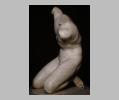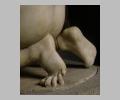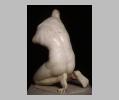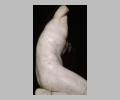
So-called "Ilioneus," back view, top

So-called "Ilioneus," right view

So-called "Ilioneus," feet, from behind

So-called "Ilioneus," back view

So-called "Ilioneus," front view of torso

So-called "Ilioneus," left view
| Collection: | Munich, Glyptothek |
| Title: | So-called "Ilioneus" |
| Summary: | Kneeling male figure, perhaps a Niobid |
| Material: | Marble |
| Sculpture Type: | Free-standing statue |
| Category: | Original/copies |
| Style: | Early Hellenistic |
| Technique: | In-the-round |
| Original or Copy: | Original? |
| Date: | ca. 325 BC - ca. 275 BC |
| Dimensions: | H 0.886 m; H (with plinth) 0.98 m; W (max.) 0.625 m; D 0.48 m. Plinth: W. 0.43 m; D 0.63 m |
| Scale: | Life-size |
| Period: | Early Hellenistic |
| In Group: | Niobid Group? |
Subject Description: A nude youth kneels in a tense position, with both feet splayed out. He bends his torso forward, and pushes both arms up--with the right shoulder above the left--probably also craning his neck to look up. Perhaps the youth is an athlete, such as an wrestler, in a contest.
Condition: Fragmentary
Condition Description: Missing head including neck, both arms below shoulder, genitals, and ends of toes. Restored, with several breaks (now repaired) across the legs. Somewhat scratched and pitted on the surface.
Material Description:
Medium-large grained marble, with dark flecks, perhaps Parian (Vierneisel-Schlörb).
Collection History: According o A. Grünwald, the statue was in the collection of Lorenzo Ghiberti, probably acquired in Rome; passed on to Monsigneur Gaddi in 1530. After the death of Gaddi, the statue was sent to Rome, to the collection of Cardinal R.P. da Carpi. Acquired by Duke Alfonse II d'Este, in Ferrara, in 1571. 1598 sent to Modena, and to the Habsburg King Rudolph II, in Prague (by 1604), where it remained until 1782/84, when it was sold to the sculptor, Malinisky. It was discovered in a corner of his garden in 1791, by Dr. Barth, who acquired it for a ducat, and took it to Vienna (in 1799?). After a restoration by J.M. Fischer, the statue was hed by Joseph Drdra, in Prague, in 1807. Finally acquired for Munich in 1814
Other Notes: This statue was previously taken to be one of the Niobids, and named for Niobe's youngest son, Ilioneus. Vierneisel-Schlörb argues against this identification on the basis of a) the active pose that suggests a single combat group; and b) the complete nudity of this figure
Sources Used:
Other Bibliography: RM 54 (1939) 225;